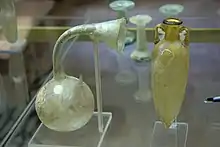Archaeological Museum of Chania
The Archaeological Museum of Chania (Greek: Αρχαιολογικό Μουσείο Χανίων) is a museum that was located in the former Venetian Monastery of Saint Francis at Chalidon Street, Chania, Crete, Greece. It was established in 1962. In 2020 this location closed and Chania's new archaeological museum[1] relocated to 15 Skra Str. Chalepa, in 2022.[2]
 | |
| Established | 1962 |
|---|---|
| Location | 28 Chalidon Street, Chania, Crete, Greece |
| Type | Archaeological museum |
Building
The exact date that the building of the original museum was constructed is unknown although it was mentioned in writing as standing during the great earthquake of 1595 and being the largest in the city.[3] It served as a Venetian church inhabited by Franciscan friars, and became an important monument of the city.[3]
During the period of the Ottoman occupation, the building was used as a mosque and named after Yussuf Pasha.[3] After World War II it served as a storehouse for military equipment, until it was converted into the museum in 1962.[3][4][5]
In 2020, the Museum closed and reopened in 2022 at a new location on Skra Street in Halepa.
 Portrait bust of a Roman man
Portrait bust of a Roman man Roman emperor Hadrian
Roman emperor Hadrian
 Late Minoan sarcophagus, 1400-1200 BC.
Late Minoan sarcophagus, 1400-1200 BC.
Interior
_1.jpg.webp)
The museum contains a substantial collection of Minoan and Roman artifacts excavated from around the city of Chania and the surrounding regional unit, including pieces from the ancient cities of Kydonia, Idramia, Aptera, Polyrinia, Kissamos, Elyros, Irtakina, Syia and Lissos, and also from Axos and Lappa in Rethymno regional unit.[6]
The museum contains a wide range of coins, jewellery, vases, sculpture, clay tablets with inscriptions, stelae and mosaics.[4]
The museum has a Roman floor mosaic,[6] depicting Dionysos and Ariadne. The Archaeological Museum of Chania also has an ancient Cycladic style vessel from Episkopi, Kissamos and a number of busts including one of Roman emperor Hadrian, found at the Dictynaion sanctuary in 1913 and a late Minoan sarcophagus from the necropolis of Armeni, dated to 1400–1200 BC. There is also a spherical flask, noted for its unusual ceramic type, dated to the Late Minoan III period.[6]
 Cycladic type tall cup, marble, 3200-2500 B.C.
Cycladic type tall cup, marble, 3200-2500 B.C. Cycladic type figurine, Koumasa variety, 2800-2200 B.C.
Cycladic type figurine, Koumasa variety, 2800-2200 B.C. Early Minoan bird-shaped vessel. Koumasa ware, 3000 - 2300 B.C.
Early Minoan bird-shaped vessel. Koumasa ware, 3000 - 2300 B.C. Model of an early Minoan ship. Odegetria Monastery area in Asteroussia, 1900 - 1700 B.C.
Model of an early Minoan ship. Odegetria Monastery area in Asteroussia, 1900 - 1700 B.C. Imprint of Minoan seal, Kastelli, 1450-1400 B.C.
Imprint of Minoan seal, Kastelli, 1450-1400 B.C. Neopalatial Minoan pottery
Neopalatial Minoan pottery Clay pyxis, Minoan funeral ceremony, 1300-1250 B.C.
Clay pyxis, Minoan funeral ceremony, 1300-1250 B.C. Clay oxen wheel, a toy, 800-700 B.C.
Clay oxen wheel, a toy, 800-700 B.C. Clay figurines of bird-faced women. Boeotioan workshop, 600 - 575 B.C.
Clay figurines of bird-faced women. Boeotioan workshop, 600 - 575 B.C. Ancient Greek golden diadem
Ancient Greek golden diadem Hellenistic glassware
Hellenistic glassware Statue of Artemis, Roman age
Statue of Artemis, Roman age Bust of Roman emperor Hadrianus
Bust of Roman emperor Hadrianus Ancient Roman glassware
Ancient Roman glassware Roman Age mosaic, Dionysos and satyr
Roman Age mosaic, Dionysos and satyr
References
- "Archaeological Museum of Chania | Directorate of Archaeological Museums, Exhibitions and Educational Programs".
- "Ξετυλίγοντας τον… μίτο του Νέου Αρχαιολογικού Μουσείου Χανίων". Χανιώτικα Νέα (in Greek). 2020-02-08. Retrieved 2021-04-10.
- "Chania Archaeological Museum". Explore Crete. Retrieved August 31, 2009.
- "Archaeological Museum of Chania". Greece Museums. Archived from the original on May 6, 2009. Retrieved August 31, 2009.
- "New Archaeological Museum of Chania in Chalepa". Crete Gazette. May 2008. Archived from the original on December 23, 2020. Retrieved August 31, 2009.
- "The Archaeological Museum of Hania". Interkriti.org. Retrieved August 31, 2009.